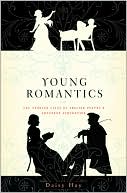|
The Tangled Lives of English Poetry’s
Greatest Generation
Daisy Hay
Farrar, Straus and Giroux
May 2010 / ISBN 978-0-374-12375-8
Biography/Memoir
Amazon
Reviewed
by Leslie Halpern
Readers don’t
have to be well acquainted with the poetry of John Keats or Mary
Shelley’s Frankenstein or the journalistic work of Leigh Hunt
to enjoy Young Romantics. However, this background knowledge about
the English Romantic era certainly helps in processing the wealth
of information contained in this nonfiction book. A time of fantastical
imaginings, attention to nature, and an emphasis on emotions, the
second generation of Romantic writers often collaborated, cohabitated,
and co-mingled in emotionally and physically intimate ways.
Despite the lurid aspects of some of these extra-marital relationships,
author Daisy Hay keeps a detached scholarly tone in retelling the
stories and linking the various people and places. In fact, the
dry writing style helps balance the book’s juicy contents.
The story begins in 1813, when the colorful cast of characters is
already young adult (for example Leigh Hunt begins a two-year prison
term for his political writings and Lord Byron initiates a sexual
relationship with his married half-sister, Augusta).
Hay proves herself a thorough researcher and reporter rather than
an insightful interpreter or storyteller. She lets the letters,
notes, poems, and portraits speak for themselves. And what they
have to say is fascinating. Fans of Percy Bysshe Shelley, Keats,
and Byron won’t be disappointed. They, and the rest of the
Romantic gang, come to life through this tangled tale.
What sets this book apart from other biographical works about the
Romantic era is its emphasis on how the lives were interwoven. The
actual poems and novels by these writers are not the focus here;
instead Hay reveals how the twisted personal lives often inspired
the creative efforts. Frequent quotations from letters support her
claims, attesting to the emotional state of these writers. More
than 20 pages of end notes and bibliography further elaborate on
the articles, books, and other works from which Hay gathered her
information.
Reviewer's
Note:
|
